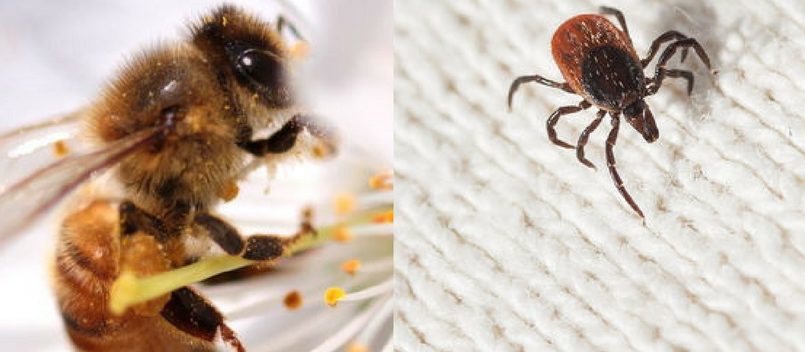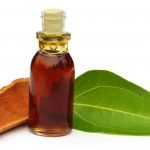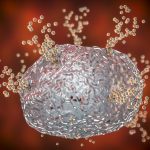Monique Hallee, BScHK, ND
Chris Hergesheimer, BA, MA
Vis Medicatrix Naturae
Reported incidence of infection by Borrelia burgdorferi (Lyme disease) is on the rise. Canadian statistics indicate that from 2009 to 2012, the number of reported cases ranged from 132 to 315 per year, increasing to 522-707 in the years 2013-2015.1 In the United States, values fluctuated from 19 931 to 29 959 per year in the years 2005-2014.2
The standard diagnostic approach to possible Lyme disease is a screening test of an enzyme immunoassay (EIA) followed by a Western blot test (performed if the EIA is positive or equivocal3). The EIA testing varies in accuracy, raising concerns about both specificity and sensitivity, while the accuracy of the Western blot can also vary based on the duration of time following infection.4 Concerns over these testing procedures add to the complexity of Lyme diagnosis.
The standard treatment for early Lyme disease involves oral antibiotics (eg, doxycycline and amoxicillin).5 Occasionally, individuals experience long-term effects following Borrelia exposure, called “Post-Treatment Lyme Disease Syndrome” (PTLDS).6 After acute exposure and antibiotic treatment, roughly 15-20% of patients have persistent musculoskeletal and cognitive complaints with fatigue. A subset of patients in this group continue to report issues beyond 6 months, giving PTLDS the colloquial name “Chronic Lyme Disease.”7 Controversy exists regarding antibiotic treatment for PTLDS, as subsequent antibiotic rounds are generally not recommended (specifically parenterally8). Some parameters, such as fatigue, may improve with antibiotics9; however, given the lack of global improvement and risk of harm associated with long-term administration, the evidence does not support their use.
The objective of this report is to highlight a possible complementary treatment involving the use of Bee Venom Therapy (BVT) in an individual with suspected PTLDS and confirmed co-infection with Bartonella bacterium. The patient had heard about my use of BVT to decrease pain and inflammation in patients with arthritis, and was curious to see whether it could also reduce the joint paint associated with her diagnosis of Lyme disease.
Case Study
A 53-year-old woman presented to our clinic seeking alternative treatment for symptoms of PTLDS. The patient had developed a bull’s eye rash after hiking in New Jersey at age 35.
She had received 3 separate ELISA tests (which were all negative, so she was never tested through Western blot). Nevertheless, she received a Lyme diagnosis from her primary care physician and was given doxycycline (6-month course) and olmesartan. Doxycycline caused a Herxheimer reaction (flu-like symptoms and fatigue) and produced only short-term positive changes. Olmesartan produced some clinical benefit, but she discontinued it when it caused vertigo.
Twelve Years Later
Twelve years after the rash, the patient experienced changes in her vision during a flare-up of her typical flu-like symptoms. The only notable preceding event was a partial hysterectomy, the scar from which appeared to have become infected but eventually cleared.
A retinal specialist diagnosed her with bilateral chronic uveitis and macular edema. Treatment included steroid injections in both eyes, steroidal eye drops, a steroidal implant inserted into her left eye (with a right eye implant scheduled for 15 days after her first visit to our naturopathic clinic), and 2 cataract surgeries with a vitrectomy 6 months prior.
Her other symptoms included high-pitched tinnitus, anosmia, stiff neck, insomnia, muscle twitches in the arms and legs, and tingling in fingers and toes (particularly on the right side). She also had memory and speech concerns, such as forgetting simple details, including her own name. She had a mild form of fluent aphasia – stringing together grammatically correct sentences with improper words.
She had self-administered a restricted diet and had been taking a multivitamin, colloidal silver, zinc, and vitamin C. All of these were stopped before the long-term trial of BVT.
Bee Venom Treatment
One week following the patient’s initial intake, BVT injections (including bee venom with equal parts procaine) were begun.
The first round of treatment involved intradermal injections of 0.1 mL per “sting”: 0.3 mL total fluid (bee venom plus procaine); the second round of injections used 0.6 mL of fluid; and all subsequent visits used 1 mL of fluid. The sites for injection were based initially on the patient’s subjective report of pain (eg, right arm, upper thoracic spine, chest, and leg), and later on were based on visual inspection of areas that had developed lesions. Injection frequency ranged from 1 to 4 weeks apart. The only other treatment administered, part way through the course of injections, was oral fish oil.
Results
The patient’s greatest improvements occurred immediately after receiving the bee venom injections, including benefits to concentration, memory, speech, and attentiveness (reduced “brain fog”); she also experienced decreases in joint pain, myalgia, and numbness/tingling.
Roughly 1 month after starting treatment, the patient appeared happier and began engaging in non-health-related conversations. Improvement in her physical appearance was also observed, as she was able to spend more time on personal grooming, such as applying make-up and styling her hair.
Improvements lasted approximately 6 days post-injection, regardless of dose.
Her symptoms intensified in the second week post-injections (and later, with more frequent self-administration of BVT). Dermal lesions appeared after a body part was injected multiple times, which expelled a small scab, resulting in a decrease in pain of the area (from 8/10 to 3/10). However, pain would then spread to other areas. Expelled material from previous injection sites originally looked like a small scab, but later was accompanied by filaments resembling fibrous material rubbed off a wool sweater, though that material had not been worn.
The patient eventually began self-administration of live bee stings 3 times per week to maintain improvement; however, additional venom led to greater susceptibility to Herxheimer reactions.
She reported no noticeable change in ocular symptoms. Her primary care physician, suspecting Bartonella infection as a possible cause, sent her for Bartonella antibody testing. This was particularly because she owned cats and her ocular symptoms began after her hysterectomy scar became infected at home. The Bartonella test was positive, so the patient was given doxycycline (100 mg BID) with rifampin (300 mg BID), later switching to rifampin with clarithromycin. With the onset of antibiotics, she decreased the frequency of BVT self-treatments, due to worsening Herxheimer reactions (nausea, fatigue, and body aches, which were usually relieved following bouts of diarrhea).
Discussion
The objective of this case report was to explore alternative treatments that might provide relief of symptoms caused by vector-borne chronic infections such as Borrelia and Bartonella spp. Statistical evidence indicates that there is little professional education and public awareness around the topic of PTLDS.7 In addition, the following topics may complicate the presentation of Lyme disease.
Co-infections
Some of the most common co-infections with Lyme disease, as reported by Smith et al,10 include those caused by Anaplasma, Babesia, and Bartonella.
The symptoms of Borrellia infections are quite similar to those that have been documented with Bartonella, such as liver or spleen enlargement,11 fatigue, and joint pain.12 Another similarity is that antibiotics do not produce favorable enough improvement to warrant their long-term use with either infection.11 Unlike Borrellia, however, the testing for Bartonella spp is less defined. Samples of lymph or blood may be used in testing methods such as polymerase chain reactions or indirect fluorescent antibody assays13; testing also depends on the specific species of Bartonella, such as B henselae (“cat-scratch disease/fever”) or quintana (“trench fever”).14
The strain of Bartonella infection known as “cat-scratch disease” (CSD) – as the name suggests – can be spread via cats, in addition to ticks. Thus, the disease is reported throughout the continental United States but does occur mostly in the northern states, as does anaplasmosis and babesiosis.10 Bartonella henselae is relevant in the case at hand. CSD symptoms may include lymphadenopathy, fever, spleen and/or liver enlargement, and endocarditis.15
CSD can also cause uveitis in up to 10% of patients,16 unlike Lyme disease in which this presentation is considered rare (and there is no standard antibiotic protocol for the condition).17 Because the chances of developing uveitis are higher with Bartonella infection than with Borrelia, it is more likely that this patient’s ocular complaints stemmed from the former. Additionally, the timeline of the patient developing uveitis 12 years following her exposure to Lyme is unlikely. Her presentation of fever followed by ocular changes matches other case reports of uveitis in those positive for Bartonella with exposure to cats.18 Cases of CSD may be self-limiting, but antibiotics like azithromycin, ciprofloxacin, rifampin, and gentamicin have produced success in select resistant cases.10
Biofilm & Preservation Tactics
Borrelia burgdorferi has been known to change forms (corkscrew, cyst, etc) under stressful environments to better sustain life in a host; however, research also suggests the likelihood of a protective defense through the microbial production of biofilm. In-vitro microscopic examinations of B burgdorferi demonstrated the spirochete’s ability to create a biofilm.19 This is much like other bacteria have been observed to do, including Bartonella quintana, which appears to use biofilm in compromising environments, such as within the feces of an organism.20 While the morphology of the biofilm made by B burgdorferi was altered depending on slide preparation for electron microscopy, the composition includes polysaccharides, proteins, nucleic acids, glycoproteins, and phospholipids.
In this study, the strong cutaneous reaction of the patient following bee venom treatment may be linked to Borellia’s (and/or Bartonella’s) production of biofilm and its possible relationship to “Morgellons disease.”21 Morgellons disease is a newly described skin disorder involving filamentous fibers observed in lesions well below the skin. The composition of these fibers appears to be unknown; likewise, the cause is unknown, though there could be a link between Lyme disease and other co-infections.21
Treatments
The controversy surrounding the efficacy of long-term antibiotics for treatment of Lyme disease and its co-infections has led to the “necessity of invention” for designing better studies22 in order to generate clearer answers. It also leads patients in search of alternatives. In this case, the main alternative method was bee venom therapy.
As Ali23 explains, BVT has been historically known as a wide-ranging therapy across many cultures and eras, with the active ingredient, “melittin,” being an effective anti-bacterial, anti-viral and anti-inflammatory. This protein and apamin are capable of increasing the body’s cortisol production and are considered to contribute to bee venom’s toxic effect.
In a study by Lubke and Garon,24 melittin alone was found to disrupt the growth of Borrelia. The spirochetes were grown on a modified Barbour-Stoenner-Kelly medium and observed with a scanning electron microscope before and after the addition of melittin. The spirochetes became distorted upon exposure to melittin, and extracellular debris was seen along with an increase in vesicular bleb formation.24 Meanwhile, darkfield microscopy revealed a dose-dependent decrease in mobility. These profound reactions did not occur, however, when melittin and phospholipase A2 were used simultaneously.
Phospholipase A2 is another component of bee venom, which, in contrast to melittin, is capable of activating the arachidonic acid cascade that results in the formation of pro-inflammatory prostaglandins.23 Thus, it has been argued that direct injection of melittin would be preferred over bee venom in its whole form.24 However, it is important to remember that there are other anti-inflammatory components in bee venom, such as “adolapin,” that receive less publicity but may also be useful. Adolapin is a built-in defense against phospholipase A2, as it is capable of blocking cyclooxygenase23 (the cycle in which arachidonic acid is metabolized).
To further block any inflammatory pathway that may be created by BVT, other natural treatments can be administered. In this case, omega-3 fish oils were chosen because of their known ability to inhibit inflammatory cyclooxygenase-2 activity.25 The patient felt this was helpful. Curiously, the administration of fish oils directly preceded the release of fibrous material from her skin.
The strengths of this individualized approach resulted in optimal health care for the patient. In a clinical setting, however, there were limitations, such as the inability to test the expelled material from the skin. Had this material been assessed for its contents, it might have illustrated a possible link to the production of biofilm. In the end, the patient also opted to self-treat by stinging herself with live bees. This was more affordable for the patient and allowed her to administer BVT on a more frequent basis. While this also allowed her to inject venom without procaine (and thus compare it to the use of venom with procaine), it also resulted in less clinical observation. In general, there seemed to be no difference to the patient when she no longer received the procaine, though this may have been offset by the increased frequency of stings. Greater levels of clinical observation might have been helpful in more closely monitoring, evaluating, and categorizing her improvements. The improvement experienced by the patient suggests that this treatment could be useful; however, it should be evaluated in larger-scale studies in a more controlled setting.
Conclusion
The evidence from this case study suggests that bee venom therapy is worth investigating for the symptomatic treatment of PTLDS or other chronic infections, including Bartonella, in patients who have not found improvement with conventional methods. The exact dosing and frequency appears to be dependent on a number of variables, such as concurrent medication use and activation of cyclooxygenase pathways. Thus, dosing bee venom should be approached with caution, as it is known to be toxic at higher levels (eg, 94 bee stings can kill a 10-kg child, even without anaphylactic allergy23). Note that frequent injections caused this patient to feel ill, particularly in conjunction with oral antibiotics. Because of the pro-inflammatory compounds found naturally in bee venom, it may be useful to co-administer natural compounds that can counter these inflammatory effects.
There are additional concerns regarding the use of BVT. Allergic reactions, reported to occur in up to 3% of the population, can be quite severe.26 Skin testing, conducted to assess reactivity to bee venom, is not fully reliable27; thus, BVT should only be used on those with previous exposure and who are confident about not having lethal reactions. To ensure safety, physicians should always take precautions by keeping antihistamines and epinephrine nearby during injections. Be aware that bee venom does cause irritation, swelling, and dose-dependent pain (larger doses can cause pain lasting several minutes26). Larger studies examining bee venom as treatment are needed, with and without the use of concurrent antibiotics.
References:
- Government of Canada. Surveillance of Lyme Disease. Last modified September 20, 2016. Government of Canada Web site. http://healthycanadians.gc.ca/diseases-conditions-maladies-affections/disease-maladie/lyme/surveillance-eng.php#a1. Accessed February 12, 2016.
- Centers for Disease Control and Prevention. Lyme Disease Data Tables: Reported cases of Lyme disease by state or locality, 2005-2015. Last updated November 21, 2016. CDC Web site. http://www.cdc.gov/lyme/stats/tables.html. Accessed February 21, 2016.
- Government of Canada. For Professionals: Lyme Disease. Last modified August 2, 2016. Government of Canada Web site. http://healthycanadians.gc.ca/diseases-conditions-maladies-affections/disease-maladie/lyme/professionals-professionnels/index-eng.php#a4. Accessed February 2, 2016.
- Branda JA, Linskey K, Kim YA, et al. Two-tiered antibody testing for Lyme disease with use of 2 enzyme immunoassays, a whole-cell sonicate enzyme immunoassay followed by a VlsE C6 peptide enzyme immunoassay. Clin Infect Dis. 2011;53(6):541-547.
- Wormser GP, Nadelman RB, Dattwyler RJ, et al. Practice guidelines for the treatment of Lyme disease. The Infectious Diseases Society of America. Clin Infect Dis. 2000;31 Suppl 1:1-14.
- Centers for Disease Control and Prevention. Post-Treatment Lyme Disease Syndrome. Last updated November 3, 2016. CDC Web site. http://www.cdc.gov/lyme/postlds/. Accessed February 26, 2016.
- Crowder LA, Yedlin VA, Weinstein ER, et al. Lyme disease and post-treatment Lyme disease syndrome: the neglected disease in our own backyard. Public Health. 2014;128(9):784-791.
- Klempner MS, Baker PB, Shapiro ED, et al. Treatment Trials for Post-Lyme Disease Symptoms Revisited. Am J Med. 2013;126(8):665-669.
- Feder HM, Johnson JB, O’Connell S, et al. A critical appraisal of “chronic Lyme Disease”. N Engl J Med. 2007;357(14):1422-1430.
- Smith A, Oertle J, Warren D, Prato D. Chronic Lyme Disease Complex and Its Commonly Undiagnosed Primary and Secondary Co-Infections. Open J Med Microbiol. 2015;5:143-158.
- Prutsky G, Domecq JP, Mori L, et al. Treatment outcomes of human bartonellosis: a systematic review and meta-analysis. Int J Infect Dis. 2013;17(10):e811-e819.
- Mascarelli PE, Maggi RG, Hopkins S, et al. Bartonella henselae infection in a family experiencing neurological and neurocognitive abnormalities after woodlouse hunter spider bite. Parasit Vectors. 2013;6(98):1-10.
- Public Health Agency of Canada. Bartonella Henselae. Last modified August 19, 2011. PHAC Web site. http://www.phac-aspc.gc.ca/lab-bio/res/psds-ftss/bartonella-henselae-eng.php. Accessed May 27, 2016.
- Nelson CA. Bartonella Infections. Last updated July 10, 2015. Centers for Disease Control and Prevention Web site. http://wwwnc.cdc.gov/travel/yellowbook/2016/infectious-diseases-related-to-travel/bartonella-infections. Accessed May 27, 2016.
- Kalogeropoulos C, Koumpoulis I, Mentis A, et al. Bartonella and intraocular inflammation: a series of cases and review of literature. Clin Ophthalmol. 2011;5:817-829.
- Chappell MC, Jumper M, McDonald R, Cunningham ET. 2011. Spotting Bartonella-Associated Uveitis. March 21, 2011. Review of Ophthalmology. https://www.reviewofophthalmology.com/article/spotting-bartonella-associated-uveitis. Accessed February 19, 2016.
- White B, Seaton RA, Evans TJ. Management of suspected Lyme borreliosis: experience from an outpatient parenteral antibiotic therapy service. QJM. 2013;106(2):133-138.
- Raihan AR, Zunaina E, Wan-Hazabbah WH, et al. Neuroretinitis in ocular bartonellosis: a case series. Clin Ophthalmol. 2014;8:1459-1466.
- Sapi E, Bastian SL, Mpoy CM, et al. Characterization of biofilm formation by Borrelia burgdorferi in vitro. PLoS One. 2012;7(10):e48277.
- Chomel BB, Boulouis HJ, Breitschwerdt EB, et al. Ecological fitness and strategies of adaptation of Bartonella species to their hosts and vectors. Vet Res. 2009;40(2):29.
- Middelveen MJ, Stricker RB. Filament formation associated with spirochetal infection: a comparative approach to Morgellons disease. Clin Cosmet Investig Dermatol. 2011;4:167-177.
- Berende A, ter Hofstede HJ, Donders AR, et al. Persistent Lyme Empiric Antibiotic Study Europe (PLEASE) – design of a randomized controlled trial of prolonged antibiotic treatment in patients with persistent symptoms attributed to Lyme borreliosis. BMC Infect Dis. 2014;14:543.
- Ali M. Studies on Bee Venom and Its Medical Uses. Int J Advancements Res Technol. 2012;1(2):1-15.
- Lubke LL, Garon CF. The antimicrobial agent melittin exhibits powerful in vitro inhibitory effects on the Lyme disease spirochete. Clin Infect Dis. 1997;25 Suppl 1:S48-S51.
- Calder PC. Mechanisms of action of (n-3) fatty acids. J Nutr. 2012;142(3):592S-599S.
- Chen J, Lariviere WR. The nociceptive and anti-nociceptive effects of bee venom injection and therapy: a double-edged sword. Prog Neurobiol. 2010;92(2):151-183.
- Golden DB. Insect sting anaphylaxis. Immunol Allergy Clin North Am. 2007;27(2):261-272, vii.
Image Copyright: <a href=’https://www.123rf.com/profile_hayatikayhan’>hayatikayhan / 123RF Stock Photo</a>
Image Copyright: <a href=’https://www.123rf.com/profile_lightpoet’>lightpoet / 123RF Stock Photo</a>
 Monique Hallee, BScHK, ND, continues to fuel her passion for medicine through contributions to the Research Department of her alma mater, giving presentations, and writing health articles for various publications. Dr Hallee is currently on maternity leave from Meditrine Naturopathic Medical Clinic in Langley, BC, where she works in family health with a focus on women’s health. If you are interested in more details of this case, or wish to share information on your own cases/research, you can reach Dr Hallee through her website: www.drhallee.com.
Monique Hallee, BScHK, ND, continues to fuel her passion for medicine through contributions to the Research Department of her alma mater, giving presentations, and writing health articles for various publications. Dr Hallee is currently on maternity leave from Meditrine Naturopathic Medical Clinic in Langley, BC, where she works in family health with a focus on women’s health. If you are interested in more details of this case, or wish to share information on your own cases/research, you can reach Dr Hallee through her website: www.drhallee.com.
 Chris Hergesheimer BA, MA, is a PhD candidate in the faculty of Land and Food Systems at the University of British Columbia. His work revolves around small-scale agriculture and value chains in the tropics. He is also Director of Research Education and is an academic instructor at the Boucher Institute of Naturopathic Medicine in New Westminster, BC.
Chris Hergesheimer BA, MA, is a PhD candidate in the faculty of Land and Food Systems at the University of British Columbia. His work revolves around small-scale agriculture and value chains in the tropics. He is also Director of Research Education and is an academic instructor at the Boucher Institute of Naturopathic Medicine in New Westminster, BC.





